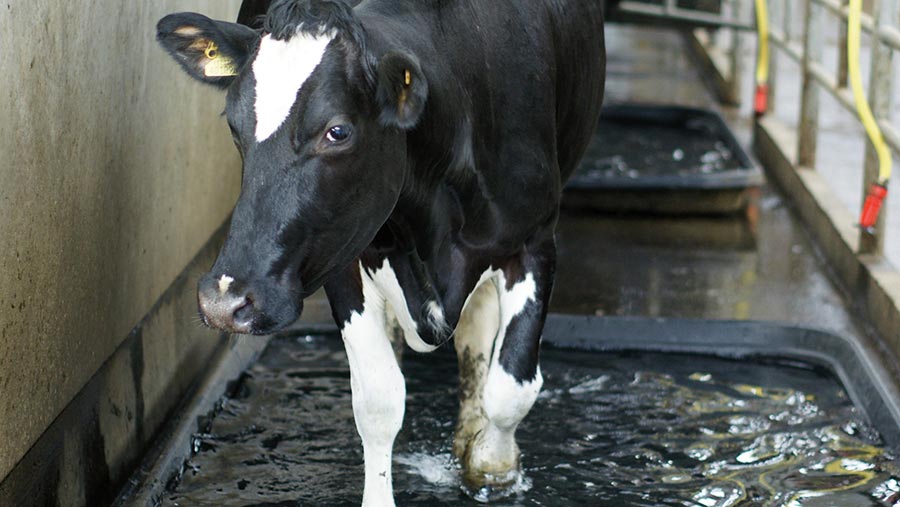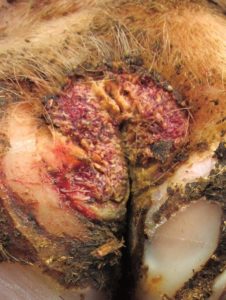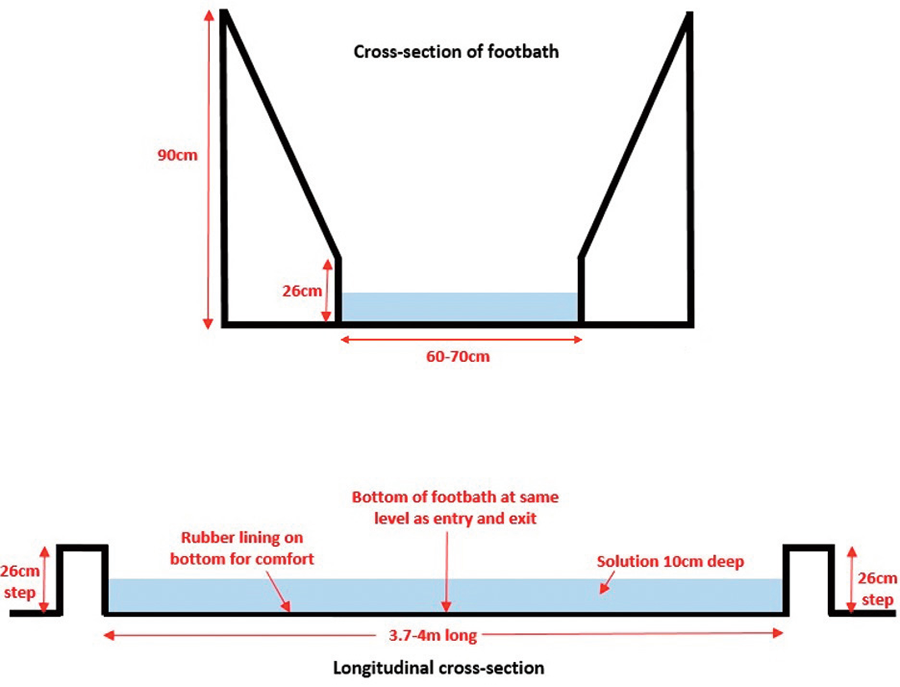How to control digital dermatitis if formalin is banned
 © Anthea Kitching
© Anthea Kitching Digital dermatitis is estimated to affect at least 70% of UK dairy herds, costing roughly £3,000 per 100 cows a year.
The traditional practice to prevent the spread of digital dermatitis is to walk the cows through a foot-bath containing formalin solution.
However, formalin has recently been reclassified from a possible carcinogenic product to a probable one – meaning it is likely capable of causing cancer.
With the future of formalin now in question, vets say the focus should be on stepping up cleanliness.
See also: Foot-bath now to avoid problems at housing
“We don’t actually know if or when the legislation is coming in – an issue which has been further confused by the Brexit vote – but it may only have a year left,” says Duncan Williams, a vet and dairy consultant at Kite Consulting.
Facts about digital dermatitis
- According to the National Animal Disease Information Service (Nadis), each case of digital dermatitis costs between £75 and £81.49, much of which is related to milk-yield loss and reduced fertility.
- Within infected herds, about 41% of cattle have lesions, although generally only a small proportion (2.8%) of these are individually treated.
So what is the best way forward?
According to Dr Williams, it’s about going back to basics.
“If we are losing more tools in the armoury, we need to go back to focusing on cow cleanliness. Cows get less digital dermatitis when they’re at grass or in regularly scraped cubicle housing with wider passageways and feed alleys.”
The importance of hygiene scoring
Dr Williams recommends using the University of Wisconsin Madison scale to objectively score cow cleanliness, as well as scoring cow comfort and lameness.
“Unless you have objective results, it’s difficult to have a true picture of the issue and to take decisive action,” he says.
“It has been proven time and again that without objective scoring, farmers underestimate levels of lameness by 50%. It is a massive welfare issue on our farms.”
He recommends using an independent mobility assessor four times a year, on top of more regular monitoring to drive treatment decisions.
The Wisconsin hygiene scale measures manure contamination of the cows’ rear feet (see “Wisconsin hygiene score”).
Wisconsin hygiene score
- One: Clean
- Two: Muck splashes
- Three: Muck plaques but hair visible
- Four: Muck plaques with no hair visible
Foot-bathing recommendations
Foot-bathing can be done as needed in herds with fewer than 25% of cows scoring a three or four, but where more than 75% score three or four, foot-bathing should be carried out daily.
However, foot-bathing is for prevention alone – it is not a treatment, warns Dr Williams.
And it’s absolutely vital to follow best-practice guidelines, otherwise the efficacy will be seriously undermined.
“Foot-bathing is often done very badly. We have a lot of plastic foot-baths in this country, which are not ideal.
“You need a well-designed foot-bath that the cows will easily flow through, filled with the right amount of solution at the right dilution.” (See “Optimal foot-bath design”).
The chemicals are also dangerous, so it’s vital that farmers take necessary safety precautions.
“Automatic foot-baths definitely carry the advantage of reduced chemical handling as well as convenience and accuracy.”
 What is digital dermatitis?
What is digital dermatitis?
Digital dermatitis is an infectious lesion that appears between the heel bulbs of cows’ feet.
It is caused by varying species of Treponeme bacteria, which, when combined with damaged or macerated skin, can potentially produce more severe disease.
The bacteria invade the skin, initially causing a red, strawberry-looking lesion, which develops into a chronic lesion that can remain for the course of the cow’s life.
Simplified, the different stages are: uninfected; active; and chronic.
The active stage is painful and is most likely to be when infectious bacteria are shed. Lesions can become active both from the chronic and the early stages.
Foot-bathing design and concentrations
Having a well-designed foot-bath means the cows will walk through calmly, rather than skipping through, reducing defecation and improving the efficacy of the treatment.
“The product and concentration rate will vary from farm to farm,” says Dr Williams.
Currently, formalin and copper sulphate are most commonly used, at rates of 2-5% and up to 10%, respectively.
“However, some cows will happily walk through formalin at 3%, while others will not.”
Alternative use to formalin
If formalin is delisted, the most likely replacement on farm will be acidified copper sulphate, which is widely used in the US.
“But you need to be very precise, and unlike normal copper sulphate, you absolutely cannot mix it with formalin as it is extremely dangerous,” warns Dr Williams.
When not using chemicals in the foot-bath, another option is to fill it with clean water, salted water, or water with detergent in it, simply to keep the cows’ feet clean, he adds.
Treatment of digital dermatitis
As foot-bathing only helps prevent digital dermatitis, it’s important to monitor active cases and treat them accordingly.
“Cows with digital dermatitis aren’t necessarily visibly lame, so make sure you monitor the incidence and severity of digital dermatitis in the parlour and when foot-trimming,” says Dr Williams.
“Any red, active lesions need treatment; this involves cleaning and spraying with topical tetracycline spray.
“Bandaging will add very little to treatment outcomes – but if bandaging is used, it must be removed within 48 hours as it can cause serious damage to the claws and can even exacerbate the problem.”
Optimal foot-bath design
- 3.7-4m long to ensure each foot is immersed three times.
- 0.6m wide – single cow width.
- 26cm step-in height, but over a ledge rather than down into a dip as cows don’t like stepping down. This depth reduces chemical loss.
- Filled to 9cm depth. Solution replaced as per product guidelines (usually one cow per litre) plus visual assessment of contamination with dung.
- Enclosed but hinged sloping sides up to 0.9m height to create a tunnel effect for better cow flow.
- Easy clean. Located on return from parlour to cow shed but not so close as to delay exit from the parlour.
- Do not use a preliminary cleaning bath – it doesn’t reduce defaecation in chemical bath and dilutes the chemical solution.
- How to calculate solution required: Length (m) x width (m) x depth of solution (m) x % solution required (eg 3%) x 10 = litres of chemical added.

Improving biosecurity
Although no-one yet knows for sure how the bacteria are spread, good biosecurity measures will help to limit the disease.
“Once you’ve got digital dermatitis you’ll never completely get rid of it, but you really can reduce the magnitude of the problem with sensible control measures.”
Biosecurity measures include running a closed herd, disinfecting boots, foot-trimming knives and vehicle wheels, and not sharing foot-trimming equipment with other farms.
“In general, any damage to the foot will allow the bacteria in the environment to invade,” warns Dr Williams.
“If you have other foot problems, such as sole ulcers or white line disease, infection with digital dermatitis on top will only make them more difficult to treat.”
